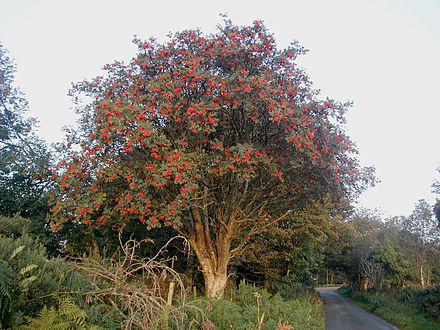Rowan
The rowans (/ˈraʊənz/ ROW-ənz or /ˈroʊənz/ ROH-ənz)[1] or mountain-ashes are shrubs or trees in the genus Sorbus of the rose family, Rosaceae. They are native throughout the cool temperate regions of the Northern Hemisphere, with the highest species diversity in the Himalaya, southern Tibet and parts of western China, where numerous apomictic microspecies occur.[2] The name rowan was originally applied to the species Sorbus aucuparia and is also used for other species in Sorbus subgenus Sorbus.[3]
Formerly, when a wider variety of fruits were commonly eaten in Europe and North America, Sorbus was a domestically used fruit throughout these regions. It is still used in some countries, but Sorbus domestica, for example, has largely vanished from Britain, where it was traditionally appreciated.[4] Natural hybrids, often including Sorbus aucuparia and the whitebeam, Sorbus aria, give rise to many endemic variants in the UK.[5]
The traditional names of the rowan are those applied to the species Sorbus aucuparia, Sorbus torminalis (wild service-tree), and Sorbus domestica (true service-tree). The Latin name sorbus was borrowed into Old English as syrfe. The name "service-tree" for Sorbus domestica is derived from that name by folk etymology. The Latin name sorbus is from a root for "red, reddish-brown" (PIE *sor-/*ser-); English sorb is attested from the 1520s in the sense "fruit of the service tree", adopted via French sorbe from Latin sorbum "service-berry".Sorbus domestica is also known as "whitty pear", the adjective whitty meaning "pinnate". The name "mountain-ash" for Sorbus domestica is due to a superficial similarity of the rowan leaves to those of the ash, not to be confused with Fraxinus ornus, a true ash that is also known as "mountain ash".[6] Sorbus torminalis is also known as "chequer tree"; its fruits, formerly used to flavour beer, are called "chequers", perhaps from the spotted pattern of the fruit.
The name "rowan" is recorded from 1804, detached from an earlier rowan-tree, rountree, attested from the 1540s in northern dialects of English and Scots. It is from a North Germanic source, derived from Old Norse reynir (c.f. Norwegian rogn, Danish røn, Swedish rönn), ultimately from the Germanic verb *raud-inan "to redden", in reference to the berries (as is the Latin name sorbus). Various dialectal variants of rowan are found in English, including ran, roan, rodan, royan, royne, round, and rune.[citation needed]
The Old English name of the rowan is cwic-beám, which survives in the name quickbeam (also quicken, quicken-tree, and variants). This name by the 19th century was reinterpreted as connected to the word witch, from a dialectal variant wick for quick and names such as wicken-tree, wich-tree, wicky, and wiggan-tree, giving rise to names such as witch-hazel[7] and witch-tree.[8]
The tree has two names in Welsh Cerdinen and criafol. Criafol may be translated as "The Lamenting Fruit", likely derived from the Welsh tradition that the Cross of Christ was carved from the wood of this tree, and the subsequent association of the Rowan's red fruit with the blood of Christ.

